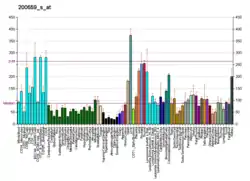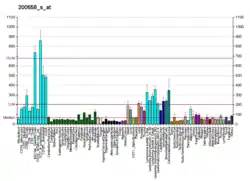Prohibitin
Prohibitin, also known as PHB, is a protein that in humans is encoded by the PHB gene.[5] The Phb gene has also been described in animals, fungi, plants, and unicellular eukaryotes. Prohibitins are divided in two classes, termed Type-I and Type-II prohibitins, based on their similarity to yeast PHB1 and PHB2, respectively. Each organism has at least one copy of each type of prohibitin gene.[6][7]
Discovery
Prohibitins are evolutionarily conserved genes that are ubiquitously expressed. The human prohibitin gene, located on the BRCA1 chromosome region 17q21, was originally thought to be a negative regulator of cell proliferation and a tumor suppressor. This anti-proliferative activity was later attributed to the 3' UTR of the PHB gene, and not to the actual protein. Mutations in human PHB have been linked to sporadic breast cancer. However, over-expression of PHB has been associated with a reduction in the androgen receptor activity and a reduction in PSA gene expression resulting in a decrease of androgen-dependent growth of cancerous prostate cells.[8] Prohibitin is expressed as two transcripts with varying lengths of 3' untranslated region. The longer transcript is present at higher levels in proliferating tissues and cells, suggesting that this longer 3' untranslated region may function as a trans-acting regulatory RNA.[5]
Function
Prohibitins may have multiple functions including:
Mitochondrial function and morphology
Prohibitins are assembled into a ring-like structure with 16–20 alternating Phb1 and Phb2 subunits in the inner mitochondrial membrane.[9] The precise molecular function of the PHB complex is not clear, but a role as chaperone for respiration chain proteins or as a general structuring scaffold required for optimal mitochondrial morphology and function are suspected. Recently, prohibitins have been demonstrated to be positive, rather than negative, regulators of cell proliferation in both plants and mice.
Transcriptional modulation
Both human prohibitins have also been suggested to be localized in the nucleus and modulate transcriptional activity by interacting with various transcription factors, including nuclear receptors, either directly or indirectly. However, little evidence for nuclear targeting and transcription factor-binding of prohibitins has been found in other organism (yeast, plants, C. elegans, etc.), indicating that this may be a specific function in mammalian cells.[10][11][12][13]
Clinical significance
Human prohibitin 1 has some activity as a virus receptor protein, having been identified as a receptor for Chikungunya Virus (CHIKV)[14] and Dengue Virus 2 (DENV-2).[15] Little else is known about the activity of the prohibitins in viral pathogenesis.
Interactions
Prohibitin has been shown to interact with:
Drugs that bind to prohibitin
- Aurilide [23]
- Fluorizoline [24][25]
- Rocaglamide A [26]
References
- GRCh38: Ensembl release 89: ENSG00000167085 - Ensembl, May 2017
- GRCm38: Ensembl release 89: ENSMUSG00000038845 - Ensembl, May 2017
- "Human PubMed Reference:". National Center for Biotechnology Information, U.S. National Library of Medicine.
- "Mouse PubMed Reference:". National Center for Biotechnology Information, U.S. National Library of Medicine.
- "Entrez Gene: PHB prohibitin".
- Van Aken O, Pecenková T, van de Cotte B, De Rycke R, Eeckhout D, Fromm H, De Jaeger G, Witters E, Beemster GT, Inzé D, Van Breusegem F (Dec 2007). "Mitochondrial type-I prohibitins of Arabidopsis thaliana are required for supporting proficient meristem development". The Plant Journal. 52 (5): 850–64. doi:10.1111/j.1365-313X.2007.03276.x. PMID 17883375.
- Mishra S, Murphy LC, Murphy LJ (2006). "The Prohibitins: emerging roles in diverse functions". Journal of Cellular and Molecular Medicine. 10 (2): 353–63. doi:10.1111/j.1582-4934.2006.tb00404.x. PMC 3933126. PMID 16796804.
- Dart, D Alwyn (2009). "Manipulating prohibitin levels provides evidence for an in vivo role in androgen regulation of prostate tumours". Endocrine-Related Cancer. 16 (4): 1157–1169. doi:10.1677/ERC-09-0028. PMC 2782800. PMID 19635783.
- Tatsuta T, Model K, Langer T (Jan 2005). "Formation of membrane-bound ring complexes by prohibitins in mitochondria". Molecular Biology of the Cell. 16 (1): 248–59. doi:10.1091/mbc.E04-09-0807. PMC 539169. PMID 15525670.
- Montano MM, Ekena K, Delage-Mourroux R, Chang W, Martini P, Katzenellenbogen BS (Jun 1999). "An estrogen receptor-selective coregulator that potentiates the effectiveness of antiestrogens and represses the activity of estrogens". Proceedings of the National Academy of Sciences of the United States of America. 96 (12): 6947–52. doi:10.1073/pnas.96.12.6947. PMC 22022. PMID 10359819.
- Gamble SC, Chotai D, Odontiadis M, Dart DA, Brooke GN, Powell SM, Reebye V, Varela-Carver A, Kawano Y, Waxman J, Bevan CL (Mar 2007). "Prohibitin, a protein downregulated by androgens, represses androgen receptor activity". Oncogene. 26 (12): 1757–68. doi:10.1038/sj.onc.1209967. PMID 16964284. S2CID 9592990.
- Kurtev V, Margueron R, Kroboth K, Ogris E, Cavailles V, Seiser C (Jun 2004). "Transcriptional regulation by the repressor of estrogen receptor activity via recruitment of histone deacetylases". The Journal of Biological Chemistry. 279 (23): 24834–43. doi:10.1074/jbc.M312300200. PMID 15140878.
- Park SE, Xu J, Frolova A, Liao L, O'Malley BW, Katzenellenbogen BS (Mar 2005). "Genetic deletion of the repressor of estrogen receptor activity (REA) enhances the response to estrogen in target tissues in vivo". Molecular and Cellular Biology. 25 (5): 1989–99. doi:10.1128/MCB.25.5.1989-1999.2005. PMC 549370. PMID 15713652.
- Wintachai P, Wikan N, Kuadkitkan A, Jaimipuk T, Ubol S, Pulmanausahakul R, Auewarakul P, Kasinrerk W, Weng WY, Panyasrivanit M, Paemanee A, Kittisenachai S, Roytrakul S, Smith DR (Nov 2012). "Identification of prohibitin as a Chikungunya virus receptor protein". Journal of Medical Virology. 84 (11): 1757–70. doi:10.1002/jmv.23403. PMID 22997079. S2CID 22172257.
- Kuadkitkan A, Wikan N, Fongsaran C, Smith DR (Oct 2010). "Identification and characterization of prohibitin as a receptor protein mediating DENV-2 entry into insect cells". Virology. 406 (1): 149–61. doi:10.1016/j.virol.2010.07.015. PMID 20674955.
- Bacher S, Achatz G, Schmitz ML, Lamers MC (Dec 2002). "Prohibitin and prohibitone are contained in high-molecular weight complexes and interact with alpha-actinin and annexin A2". Biochimie. 84 (12): 1207–20. doi:10.1016/s0300-9084(02)00027-5. PMID 12628297.
- Wang S, Nath N, Fusaro G, Chellappan S (Nov 1999). "Rb and prohibitin target distinct regions of E2F1 for repression and respond to different upstream signals". Molecular and Cellular Biology. 19 (11): 7447–60. doi:10.1128/mcb.19.11.7447. PMC 84738. PMID 10523633.
- Joshi B, Ko D, Ordonez-Ercan D, Chellappan SP (Dec 2003). "A putative coiled-coil domain of prohibitin is sufficient to repress E2F1-mediated transcription and induce apoptosis". Biochemical and Biophysical Research Communications. 312 (2): 459–66. doi:10.1016/j.bbrc.2003.10.148. PMID 14637159.
- Fusaro G, Dasgupta P, Rastogi S, Joshi B, Chellappan S (Nov 2003). "Prohibitin induces the transcriptional activity of p53 and is exported from the nucleus upon apoptotic signaling". The Journal of Biological Chemistry. 278 (48): 47853–61. doi:10.1074/jbc.M305171200. PMID 14500729.
- Wang S, Zhang B, Faller DV (Jun 2002). "Prohibitin requires Brg-1 and Brm for the repression of E2F and cell growth". The EMBO Journal. 21 (12): 3019–28. doi:10.1093/emboj/cdf302. PMC 126057. PMID 12065415.
- Wang S, Fusaro G, Padmanabhan J, Chellappan SP (Dec 2002). "Prohibitin co-localizes with Rb in the nucleus and recruits N-CoR and HDAC1 for transcriptional repression". Oncogene. 21 (55): 8388–96. doi:10.1038/sj.onc.1205944. PMID 12466959.
- Wang S, Nath N, Adlam M, Chellappan S (Jun 1999). "Prohibitin, a potential tumor suppressor, interacts with RB and regulates E2F function". Oncogene. 18 (23): 3501–10. doi:10.1038/sj.onc.1202684. PMID 10376528.
- Sato S, Murata A, Orihara T, Shirakawa T, Suenaga K, Kigoshi H, Uesugi M (Jan 2011). "Marine natural product aurilide activates the OPA1-mediated apoptosis by binding to prohibitin". Chemistry & Biology. 18 (1): 131–9. doi:10.1016/j.chembiol.2010.10.017. PMID 21276946.
- Pérez-Perarnau A, Preciado S, Palmeri CM, Moncunill-Massaguer C, Iglesias-Serret D, González-Gironès DM, Miguel M, Karasawa S, Sakamoto S, Cosialls AM, Rubio-Patiño C, Saura-Esteller J, Ramón R, Caja L, Fabregat I, Pons G, Handa H, Albericio F, Gil J, Lavilla R (Sep 2014). "A trifluorinated thiazoline scaffold leading to pro-apoptotic agents targeting prohibitins". Angewandte Chemie. 53 (38): 10150–4. doi:10.1002/anie.201405758. PMID 25196378.
- Moncunill-Massaguer C, Saura-Esteller J, Pérez-Perarnau A, Palmeri CM, Núñez-Vázquez S, Cosialls AM, González-Gironès DM, Pomares H, Korwitz A, Preciado S, Albericio F, Lavilla R, Pons G, Langer T, Iglesias-Serret D, Gil J (Dec 2015). "A novel prohibitin-binding compound induces the mitochondrial apoptotic pathway through NOXA and BIM upregulation". Oncotarget. 6 (39): 41750–65. doi:10.18632/oncotarget.6154. PMC 4747186. PMID 26497683.
- Polier G, Neumann J, Thuaud F, Ribeiro N, Gelhaus C, Schmidt H, Giaisi M, Köhler R, Müller WW, Proksch P, Leippe M, Janssen O, Désaubry L, Krammer PH, Li-Weber M (Sep 2012). "The natural anticancer compounds rocaglamides inhibit the Raf-MEK-ERK pathway by targeting prohibitin 1 and 2". Chemistry & Biology. 19 (9): 1093–104. doi:10.1016/j.chembiol.2012.07.012. PMID 22999878.
Further reading
- McClung JK, Jupe ER, Liu XT, Dell'Orco RT (1996). "Prohibitin: potential role in senescence, development, and tumor suppression". Experimental Gerontology. 30 (2): 99–124. doi:10.1016/0531-5565(94)00069-7. PMID 8591812. S2CID 9075146.
- Dell'Orco RT, McClung JK, Jupe ER, Liu XT (1996). "Prohibitin and the senescent phenotype". Experimental Gerontology. 31 (1–2): 245–52. doi:10.1016/0531-5565(95)02009-8. PMID 8706794. S2CID 22817314.
- Mishra S, Murphy LC, Nyomba BL, Murphy LJ (Apr 2005). "Prohibitin: a potential target for new therapeutics". Trends in Molecular Medicine. 11 (4): 192–7. doi:10.1016/j.molmed.2005.02.004. PMID 15823758.
- Rajalingam K, Rudel T (Nov 2005). "Ras-Raf signaling needs prohibitin". Cell Cycle. 4 (11): 1503–5. doi:10.4161/cc.4.11.2142. PMID 16294014.
- Sato T, Saito H, Swensen J, Olifant A, Wood C, Danner D, Sakamoto T, Takita K, Kasumi F, Miki Y (Mar 1992). "The human prohibitin gene located on chromosome 17q21 is mutated in sporadic breast cancer". Cancer Research. 52 (6): 1643–6. PMID 1540973.
- Dawson SJ, White LA (May 1992). "Treatment of Haemophilus aphrophilus endocarditis with ciprofloxacin". The Journal of Infection. 24 (3): 317–20. doi:10.1016/S0163-4453(05)80037-4. PMID 1602151.
- White JJ, Ledbetter DH, Eddy RL, Shows TB, Stewart DA, Nuell MJ, Friedman V, Wood CM, Owens GA, McClung JK (Sep 1991). "Assignment of the human prohibitin gene (PHB) to chromosome 17 and identification of a DNA polymorphism". Genomics. 11 (1): 228–30. doi:10.1016/0888-7543(91)90126-Y. PMID 1684951.
- Altus MS, Wood CM, Stewart DA, Roskams AJ, Friedman V, Henderson T, Owens GA, Danner DB, Jupe ER, Dell'Orco RT (Jun 1995). "Regions of evolutionary conservation between the rat and human prohibitin-encoding genes". Gene. 158 (2): 291–4. doi:10.1016/0378-1119(95)00164-2. PMID 7607556.
- Ikonen E, Fiedler K, Parton RG, Simons K (Jan 1995). "Prohibitin, an antiproliferative protein, is localized to mitochondria". FEBS Letters. 358 (3): 273–7. doi:10.1016/0014-5793(94)01444-6. PMID 7843414. S2CID 31600675.
- Maruyama K, Sugano S (Jan 1994). "Oligo-capping: a simple method to replace the cap structure of eukaryotic mRNAs with oligoribonucleotides". Gene. 138 (1–2): 171–4. doi:10.1016/0378-1119(94)90802-8. PMID 8125298.
- Sato T, Sakamoto T, Takita K, Saito H, Okui K, Nakamura Y (Sep 1993). "The human prohibitin (PHB) gene family and its somatic mutations in human tumors". Genomics. 17 (3): 762–4. doi:10.1006/geno.1993.1402. PMID 8244394.
- Jupe ER, Liu XT, Kiehlbauch JL, McClung JK, Dell'Orco RT (Apr 1996). "The 3' untranslated region of prohibitin and cellular immortalization". Experimental Cell Research. 224 (1): 128–35. doi:10.1006/excr.1996.0120. PMID 8612677.
- Suzuki Y, Yoshitomo-Nakagawa K, Maruyama K, Suyama A, Sugano S (Oct 1997). "Construction and characterization of a full length-enriched and a 5'-end-enriched cDNA library". Gene. 200 (1–2): 149–56. doi:10.1016/S0378-1119(97)00411-3. PMID 9373149.
- Rasmussen RK, Ji H, Eddes JS, Moritz RL, Reid GE, Simpson RJ, Dorow DS (May 1998). "Two-dimensional electrophoretic analysis of mixed lineage kinase 2 N-terminal domain binding proteins". Electrophoresis. 19 (5): 809–17. doi:10.1002/elps.1150190535. PMID 9629920. S2CID 21204230.
- Wang S, Nath N, Adlam M, Chellappan S (Jun 1999). "Prohibitin, a potential tumor suppressor, interacts with RB and regulates E2F function". Oncogene. 18 (23): 3501–10. doi:10.1038/sj.onc.1202684. PMID 10376528.
- Wang S, Nath N, Fusaro G, Chellappan S (Nov 1999). "Rb and prohibitin target distinct regions of E2F1 for repression and respond to different upstream signals". Molecular and Cellular Biology. 19 (11): 7447–60. doi:10.1128/mcb.19.11.7447. PMC 84738. PMID 10523633.
- Hartley JL, Temple GF, Brasch MA (Nov 2000). "DNA cloning using in vitro site-specific recombination". Genome Research. 10 (11): 1788–95. doi:10.1101/gr.143000. PMC 310948. PMID 11076863.
- Coates PJ, Nenutil R, McGregor A, Picksley SM, Crouch DH, Hall PA, Wright EG (May 2001). "Mammalian prohibitin proteins respond to mitochondrial stress and decrease during cellular senescence". Experimental Cell Research. 265 (2): 262–73. doi:10.1006/excr.2001.5166. PMID 11302691.
- Van Aken O, Pecenková T, van de Cotte B, De Rycke R, Eeckhout D, Fromm H, De Jaeger G, Witters E, Beemster GT, Inzé D, Van Breusegem F (Dec 2007). "Mitochondrial type-I prohibitins of Arabidopsis thaliana are required for supporting proficient meristem development". The Plant Journal. 52 (5): 850–64. doi:10.1111/j.1365-313X.2007.03276.x. PMID 17883375.






